WORLD CLASS COACHING
Build Up From the Back - Exercises 1
By Luca Bertolini
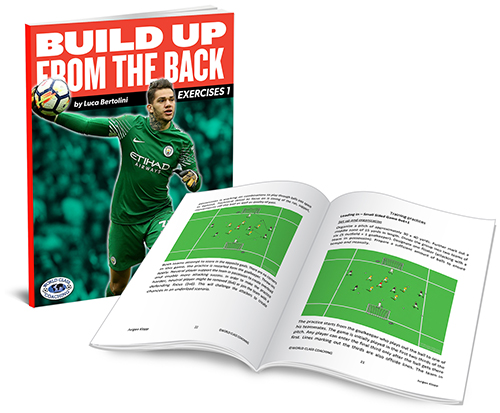
Table of Contents
PART FOUR
The La Volpe Exit
Possession Rondos and Position Games
The La Volpe Exit
All the following exercises are designed to coach the timing of movements of the key players who are involved in this famous building up from the back sequence:

• Goalkeeper in possession
• Center backs move wide
• Center balance player drops back in between the center back
• Fullbacks move forward
Despite its application all over the world, consider these aspects before practicing:
• It must be adapted to the context or the team build up sequence can become a predictable strategy
• If the opposition team neutralizes the exit with a sign, the possession team must have other available passing lanes
• The timing in decision making is a priority
Exercise 27
Set-up: 8 players are placed as in the picture. From the bottom, they play as:
1) goalkeepers
2) center backs
3) fullbacks
4) balance midfielders
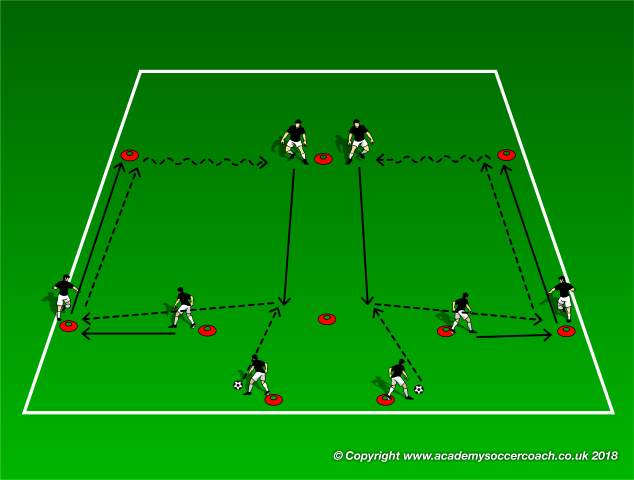
Sequence: the players at the bottom are in possession as if they were goalkeepers. The balance players drop back to receive, while the center backs run wide and the fullbacks run forward. The center backs must control the ball on the outer cones and then pass forward on the run of the fullbacks, who receive wide on the cone and dribble inside first...
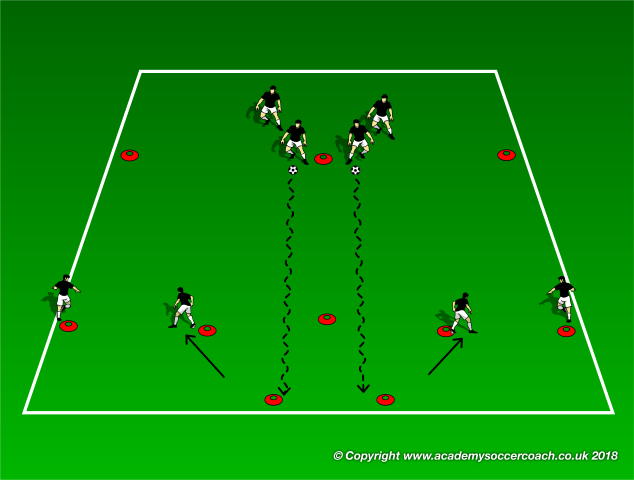
...and then backward on the cones at the bottom. The players move toward the next cone. The sequence is carried out on the right and on the left at the same time.
Eye on: quality of the passes, synchronization of deep, wide and forward runs.
Exercise 28
Set-up: 6 players are placed as in the picture. From the bottom, the players are:
1) goalkeeper
2) center backs
3) fullbacks
4) balance midfielder
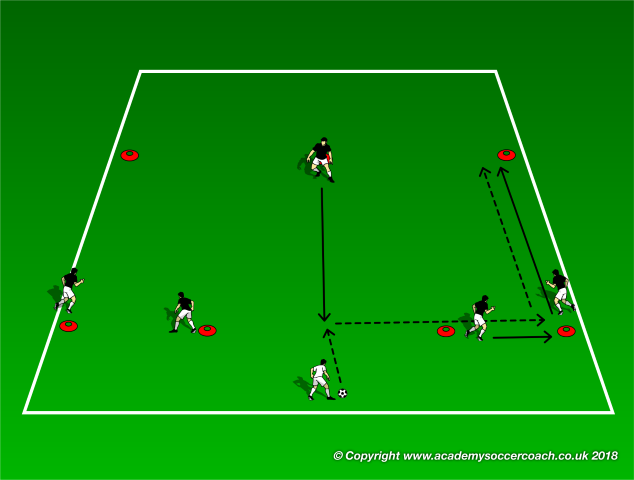
Sequence: the goalkeeper at the bottom is in possession and he calls for the side where the sequence has to be started. The balance player drops back to receive, while the center back runs wide and the fullback runs forward. The center back must control the ball on the outer cones and then pass forward on the run of the fullback, who receives up and wide on the cone.
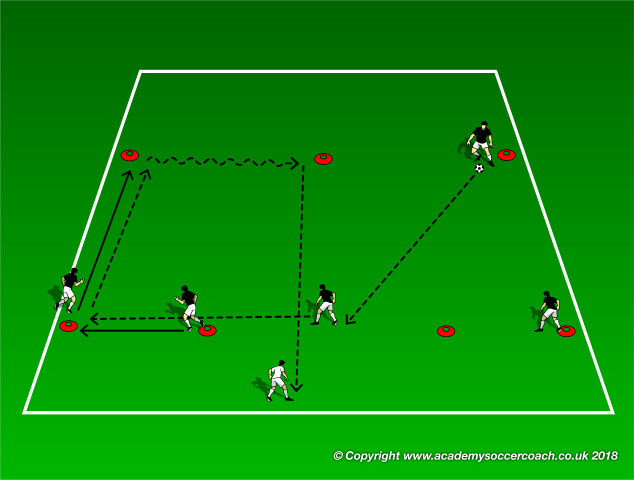
The fullback then turns and he passes back to the balance player, who is now on the defense line. The balance player passes the ball out on the run of the opposite center back and then the fullback receive the ball on the upper cone, before dribbling the ball toward the center and passing back to the goalkeeper.
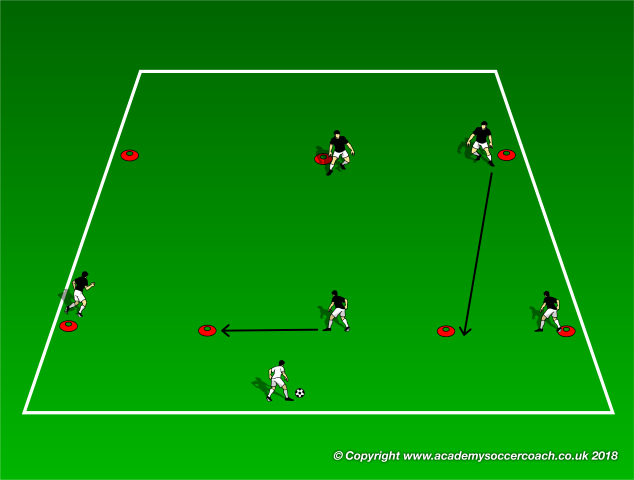
All the players rotate their positions toward the next cone; the first fullback becomes center back and the balance player becomes the opposite center back.
Eye on: quality of the passes, synchronization of deep, wide and forward runs on the first side of play, quick combination to change the side of play.
Exercise 29
Set-up: 8 players are placed as in the picture. From the bottom, they play as:
1) goalkeepers
2) center backs
3) fullbacks
4) balance midfielders
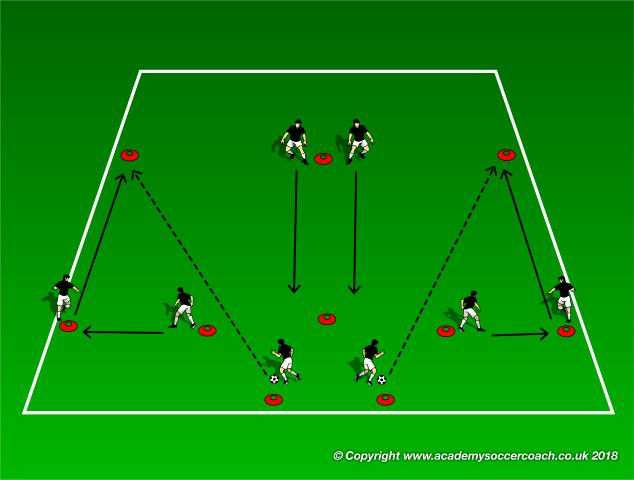
Sequence: the players at the bottom are in possession as if they were goalkeepers. The balance players drop back to receive, while the center backs run wide and the fullback run forward. The fullbacks receive a direct pass from the "goalkeepers"...
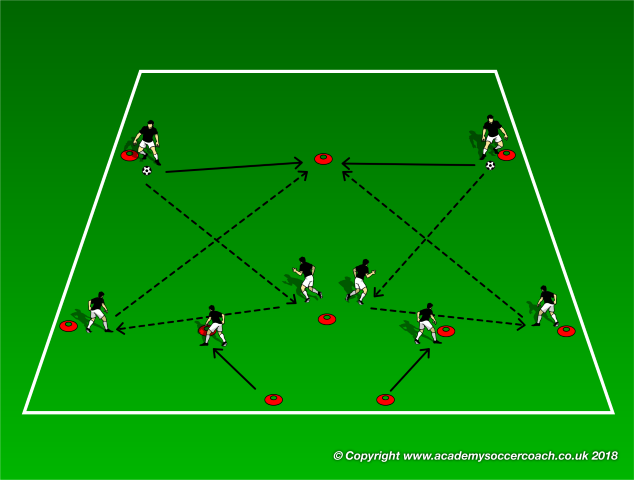
...they turn and pass back to the balance players, to distribute to the center backs on the left and on the right. The center backs pass then toward the upper cone where the fullbacks receive...
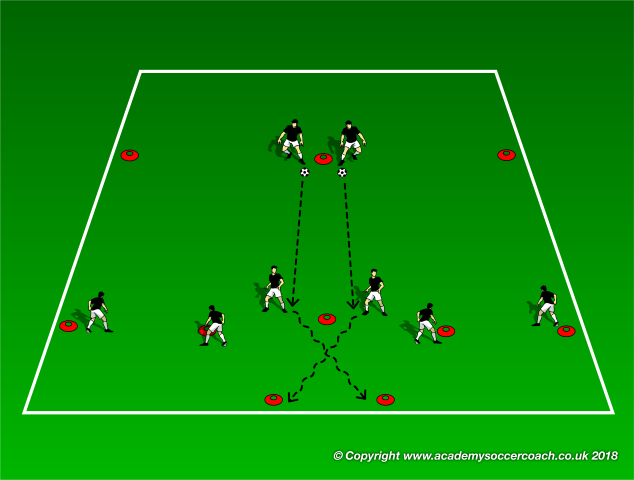
... and the balance players receive the last pass and dribble back to the bottom, while they are crossing their runs.
Eye on: quality of the passes, synchronization of deep, wide and forward runs.
Exercise 30
Set-up: 6 players are placed as in the picture. From the bottom, they play as:
1) goalkeepers
2) center backs
3) fullbacks
4) balance midfielders
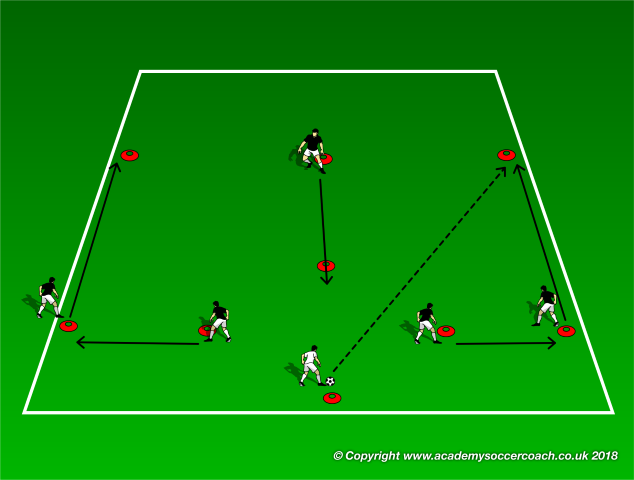
Sequence: the goalkeeper at the bottom is in possession and he calls for the side where the sequence has to be started. The balance player drops back to receive, while the center backs run wide and the fullbacks run forward. The right fullback in the picture receives a direct pass from the goalkeeper being placed wide on the upper cone.
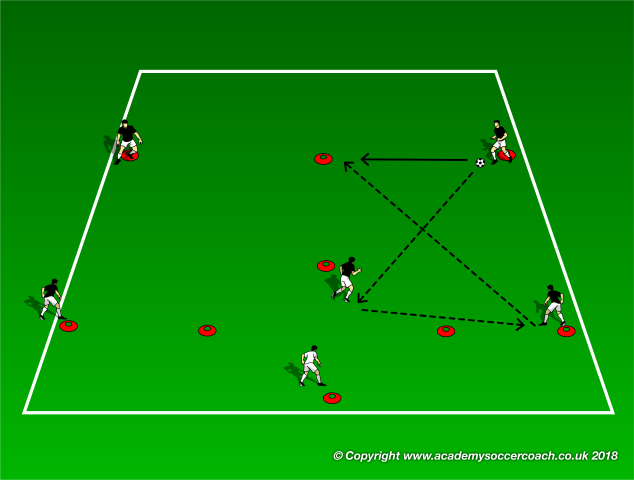
As the fullback is on the upper cone, he turns and he passes back to the balance player on the defense line. The center balance player plays wide on the right toward the center back, who passes forward again toward the inside run of the fullback.
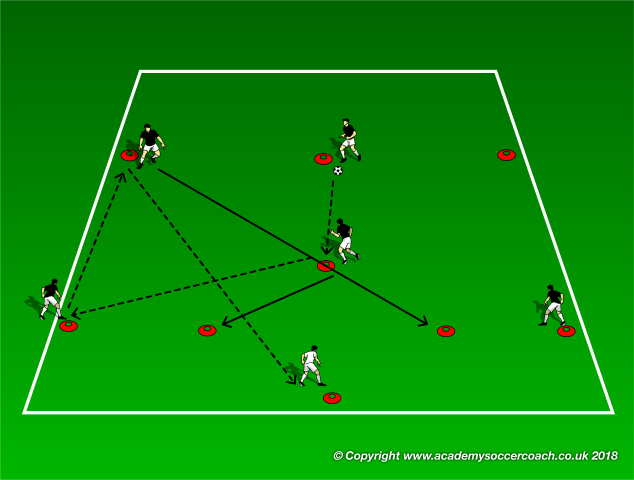
As the fullback receives, he passes back again to center balance player, who changes direction toward the center back. The opposite fullback then receives on the upper cone on the left side and the goalkeeper receives the last pass to start the sequence again. The balance player and the second left fullback become center backs.
Eye on: quality of the passes, synchronization of deep, wide and forward runs on the first side of play, quick combination to change the side of play.
Possession, Rondos and Position Games
All the following exercises aim to practice the principles of play to build up under active pressure of the opponents; this way, the build up phase, transitions, the possession phase under pressure, the play out under pressure phase are all coached at the same time, as well as the positioning and re-positioning of the players. If all the previous exercises improve the basic technique, the body positioning, the body angle to progress on the pitch as the ball is received, these small sided games are useful to coach the players under pressure and put them into real game situations.
The players must stay on the ball with an open stance ready to receive from any side or forward direction. They must be focused and think quickly as well as to have speed of play as the team demands a high level of performance from each player. Creativity and teamwork must be key words to fix the issues of the opposition. Keeping possession as player and as team must be the first aim, but to look for opportunities to cut the opposition lines when possible is very important. The rhythm of the passes must recall the technical exercises; the tempo of play and the rhythm are critical for team success.
These are the three main way of passing the ball, that the player should try to look for, to break through the opposition lines of pressure, in these kind of exercises:
• First Line Break/Pass: pass to the teammate next to you. The easiest pass to perform in a rondo as it doesn't require a wide range of vision (possession)
• Second Line Break/Pass: the pass will bypass the teammate next to you but it doesn't split defenders. The second line pass requires a little larger passing vision; it's more difficult than the first line pass (move the opponents)
• Third Line Split Pass: this is the pass that splits the defenders through the middle. It requires skill, creativity, vision and timing of play. In soccer the ultimate goal is to get the ball forward and score. Third line split passes help to develop this skill (break the pressure line)
How to use the exercise and how to progress in a training session with build up of play as first objective:

Exercise 30: multiple 2 v 1s
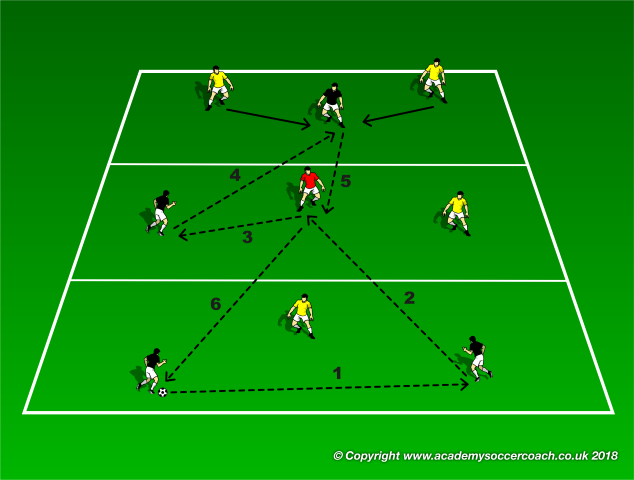
Set-up and Sequence: nine players are placed inside a 3 areas rectangular space; two teams of four play a 2 v 1 duel inside the outer areas and a 1 v 1 + 1 free player in the middle.
The goal for the team in possession is to win the 2 v 1 duel while building up with the fewer number of touches possible and to progress quickly in the middle, utilizing the free player.
As the forward receives being outnumbered, he must be able to keep the possession and to send the ball back in the building up area to continue the sequence. If the defending team wins the possession, the objective is the same.
Variation: the center free player is a defender, so the receiver must play with one touch if possible.
Eye on: quality of the passes, quick combinations, closure of passing lanes and immediate pressure to win the ball back.
Exercise 31: support play in 3 v 1, 2 v 1 and 2 v 2 duels
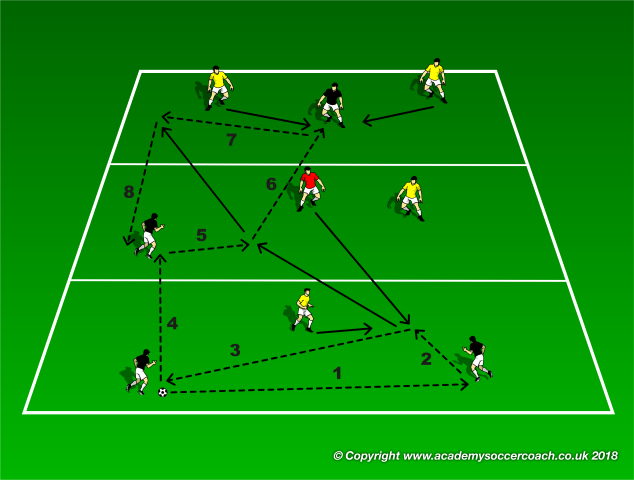
Set-up and Sequence: nine players are placed inside a 3 areas rectangular space; two teams of four play a 2 v 1 duel inside the outer areas and a 1 v 1 + 1 in the middle.
The goal for the team in possession is to create and win a 3 v 1 duel while building up with the fewest number of touches possible and to progress quickly in the middle, thanks to the free player.
As the midfielder receives, he's playing a 1 v 1 duel and the free player must support him, creating a 2 v 1 to send the ball up the pitch. The midfielder must then support the forward in keeping the possession, as he's outnumbered at the beginning, equalizing the tactical situation in a 2 v 2 duel. The objective is to keep possession and to repeat the sequences as many time as possible. If the defending team wins the possession, the objective is the same.
Variation: the center free player is a defender, creating a 2 v 2 to counter the build up phase, a 1 v 2 in the middle to recover the possession and a 3 v 2 inside the upper part to put pressure.
Eye on: quality of the passes, support play to help the teammate in possession, quick combinations, closure of passing lanes and immediate pressure to win the ball back.
Exercise 32: multiple 3 v 2 duels
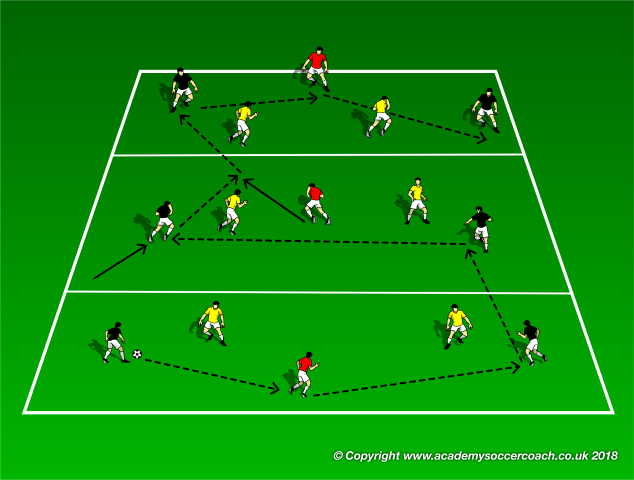
Set-up and Sequence: fifteen players are placed inside a 3 areas rectangular space; two teams of six play multiple 3 (2+1) v 2 duels inside all the areas; one free player is placed in the middle of each space, to create numerical advantage for the team in possession.
The goal for the team in possession is to win the duels as soon as possible and with the fewer number of touches.
The lines of pressure should be broken through with 1-2 passing combinations with the receiving of return passes behind the defenders. The possession must be maintained all over the areas.
Variation: the free players can become defenders, to make the possession team building up in an outnumbered situation, playing out outnumbered, as well as to keep the possession in the same situation.
Eye on: quality of the passes, quick combinations to progress up the pitch, closure of passing lanes and immediate pressure to win the ball back.
Exercise 33: multiple 3 v 2 duels
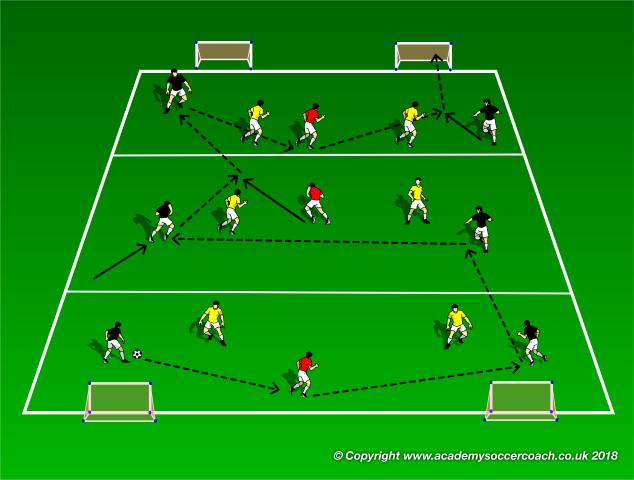
Set-up and Sequence: this exercise is a progression of the previous one. The teams have two mini goals to attack and two to be saved; every time the possession is being played in the finishing area, a score chance shall be created as soon as possible and with the fewer number of touches.
Variation: the free players can become defenders, to make the possession team building up in an outnumbered situation, playing out outnumbered, as well as to finish in the same situation. The team in possession must be fast and effective. As the defenders recover the ball, they must be quick the same, as the free players become defenders immediately; quick transitions to attack and to defend are then required.
Eye on: quality of the passes, quick combinations to progress on the pitch, fast finishing, closure of passing lanes and immediate pressure to win the ball back.
Exercise 34: multiple 3 v 2 rondo
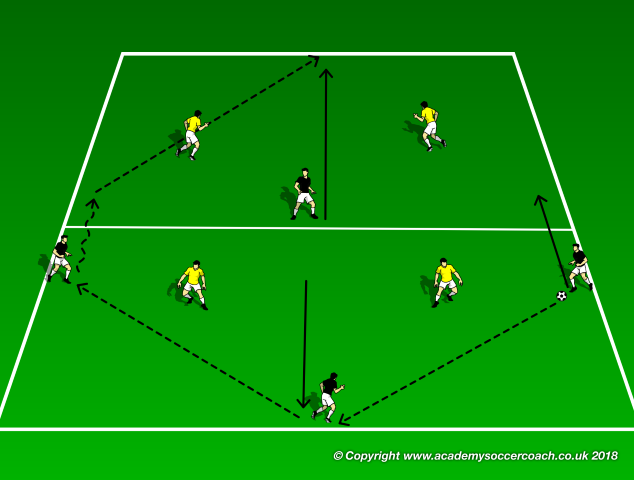
Set-up and Sequence: two teams of four players are placed inside a two area rectangular space as in the picture. The possession team players are along the sidelines and the defenders are placed in the middle of two areas.
The goal for the team in possession is to win the 3 v 2 duels through wide passes and to take the move on the other half time to time. The lower vertex must always drop back from the middle line.
If the defenders win the ball, all the players must replace themselves along the lines to manage the possession and in the middle to defend.
Variation: one defender can run inside the playing half to create a 3 v 3 duel; the player who is placed along the middle line can be involved to create a 4 v 3 duel.
Eye on: quality of the passes, quick dribble of the ball to progress on the pitch, closure of passing lanes and immediate pressure to win the ball back.
Exercise 35: double 3 v 3 + 1 position game
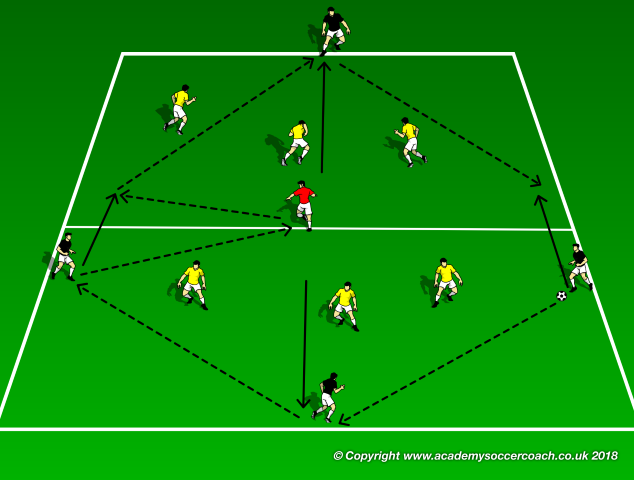
Set-up and Sequence: two teams of four players (the black one) and of six (the yellow one) together with a center red midfielder are placed inside a two areas rectangular space, as in the picture. The possession team players are placed along the sidelines and the defenders are placed in the middle of two areas.
The possession team is placed on the field with a balance midfielder and two center backs in every half of the area; the red center midfielder is a target player who must receive behind the defense lines of three to progress the move toward the other area time to time. The goal for the team in possession is to win the 3 v 3 duels to play through the center and to change the half field.
If the defenders win the ball, all the players must replace themselves along the lines of the half pitch, where the ball was won to manage the possession and in the middle to defend.
Variation: one defender can run inside the playing half to create a 3 + 1 v 4 duel.
Eye on: quality and quickness of the passes, closure of passing lanes and immediate pressure to win the ball back.
Exercise 36: double 3 v 3 + 3 position game
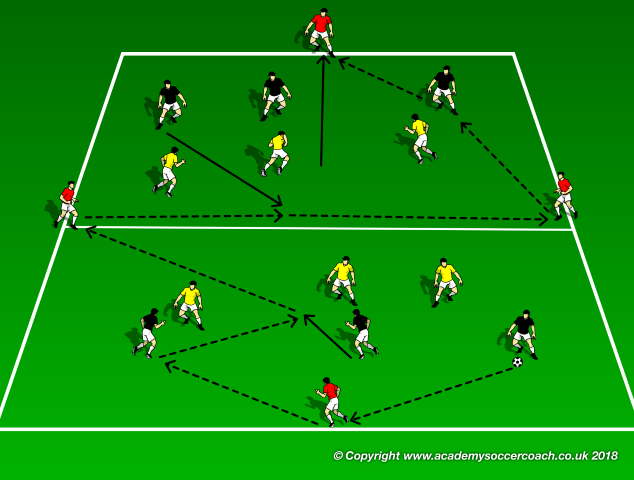
Set-up and Sequence: two teams of six (the black and the yellow one) together with four red free players are placed inside a two areas rectangular space, as in the picture. The red free players are placed along the sidelines.
The possession and the defending team are placed inside the field with a red balance midfielder and two center backs in every half of the area; the red center midfielder is a target player who must receive behind the defense lines to progress the move toward the other area time to time. The goal for the team in possession is to win the 3 v 3 duels to change the half area.
If the defenders win the ball, they change the role inside the area where the possession was won and they must try to change the side as soon as possible.
Variation: one defender can run inside the playing half from the other one to create a 3 + 1 v 4 duel.
Eye on: quality and quickness of the passes, closure of passing lanes and immediate pressure to win the ball back.


